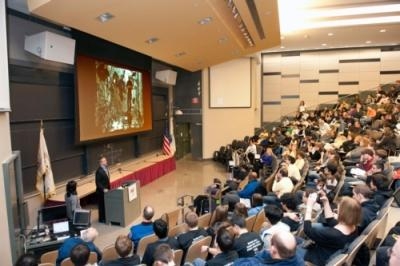Nationwide Robotics Competition Brings Together Young Aerospace
Engineers On Earth
Twenty seven teams of high school students from across the
United States competed in the Zero Robotics SPHERES Challenge which
took place at MIT in Cambridge, MA and aboard the International
Space Station (ISS) this week. "Team Rocket" from River Hill High
School, Maryland, "Storming Robots" from Storming Robots LLC, of
New Jersey and "SPHEREZ of Influence" from Rockledge High School,
Florida posted the best cumulative score out of 9 multi team
'alliances' seeing their code tested in space by real
astronauts.

Known collectively as "Alliance Rocket," the students from
Clarksville, Branchburg and Rockledge collaborated by programming
software code which enabled miniature basketball-sized satellites
called SPHERES, (Synchronized Position Hold Engage and Reorient
Experimental Satellites) aboard the ISS to find tools, reach
imaginary asteroids, collect a 'sample' of Helium-3 and deposit it
in a virtual processing station. The final heats of the tournament
took place aboard the orbiting International Space Station as the
competing teams watched live on screens at the MIT campus on
Earth.
"The students of Team Rocket learned to work as a team in an
exciting real life experience solving a challenging problem
involving strategy and analysis while combining their knowledge of
computer programming, physics and calculus," said Anne Contney,
Computer Science teacher at River Hill High School. "They
were introduced to careers in engineering, computer programming and
space science. Their mentors taught, challenged and inspired them
to become champions and achieve beyond their wildest dreams."
The idea for Zero Robotics originated with astronaut Greg
Chamitoff, an MIT graduate and a flight engineer and science
officer during Expeditions 17 and 18 on the space station. SHPERES
has been operating on the ISS since 2006. The goal of the program
is to build critical engineering skills for students, such as
problem solving, design thought process, operations training and
team work. Students are not required to have previous programming
experience before the project. After a tutorial on how to program
the robots, the teams strategize, design and test their coded
solutions in a computer simulation environment.
"This year's tournament involved two contradicting activities:
competition and collaboration," said Alvar Saenz-Otero, lead
scientist of the SPHERES project. "It was very exciting to see how
teams developed strategies that helped them collaborate to gain the
most points while maintaining a competitive advantage."
The TopCoder software community built the NASA and DARPA-funded
competition platform as part of the challenge to conduct
experiments with satellites aboard the International Space Station.
The community has been working with MIT Space Systems Lab and
Aurora Flight Sciences under the sponsorship of NASA and DARPA to
create the competition. SPHERES was originally developed to
demonstrate the basics of formation flight, autonomous docking and
other multi-spacecraft control algorithms, using beacons as
reference for the satellites, to fly formation with or dock to the
beacon. A number of programs define various incremental tests
including attitude control (performing a series of rotations),
attitude-only tracking, attitude and range tracking, docking with
handheld and mounted beacons, etc. Formation flight and autonomous
docking are important enabling technologies for distributed
architectures. Each satellite has 12 thrusters and a tank with CO2
for propellant.
TopCoder's expertise in the world of online programming
competitions that deliver quality software has been used to create
a custom platform and interface designed to make students' ideas
for experiments become reality and to inspire future scientists and
engineers so that they will view working in space as "normal," and
will grow up pushing the limits of engineering and space
exploration.
Zero Robotics opens the state of the art research facilities on
the ISS to high-school students who write programs that may
actually control a satellite in space. The competitions require
students to develop an understanding of how to make these
satellites work together. Such swarms of satellites could be used
to create giant telescope mirrors in space with precision and
assemble future space stations without the need for human
spacewalks. (Image provided by TopCoder)
 Unfortunate... ANN/SportPlane Resource Guide Adds To Cautionary Advisories
Unfortunate... ANN/SportPlane Resource Guide Adds To Cautionary Advisories ANN FAQ: Turn On Post Notifications
ANN FAQ: Turn On Post Notifications ANN's Daily Aero-Term (04.29.24): Visual Approach Slope Indicator (VASI)
ANN's Daily Aero-Term (04.29.24): Visual Approach Slope Indicator (VASI) ANN's Daily Aero-Term (04.28.24): Airport Marking Aids
ANN's Daily Aero-Term (04.28.24): Airport Marking Aids ANN's Daily Aero-Linx (04.28.24)
ANN's Daily Aero-Linx (04.28.24)



